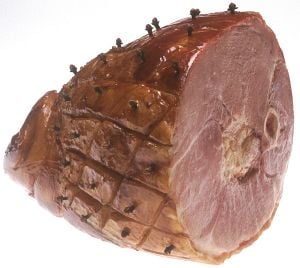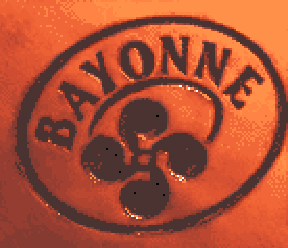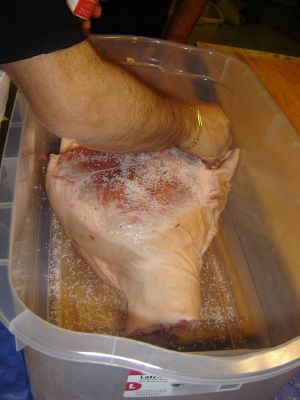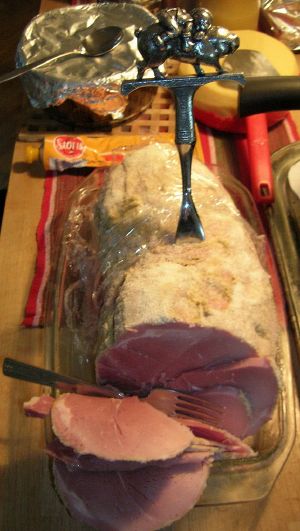Ham

Ham is the thigh and rump of any animal that is slaughtered for meat, but the term is usually restricted to a cut of pork, the haunch of a pig or boar. Although it can be cooked and served fresh, most ham is cured in some fashion.
Ham can either be dry-cured or wet-cured. A dry-cured ham has been rubbed in a mixture containing salt and a variety of other ingredients (most usually some proportion of sodium nitrate and sodium nitrite), Sugar is common in many dry cures in the United States. This is followed by a period of drying and ageing. Dry-cured hams may require a period of rehydration prior to consumption. A wet-cured ham has been cured with a brine, either by immersion or injection. The division between wet and dry cure is not always hard-and-fast as some ham curing methods begin wet but are followed by dry aging.
The majority of common wet-cured ham available in U.S. supermarkets is of the "city ham" variety,[citation needed] in which brine is injected into the meat for a very rapid curing suitable for mass market. Traditional wet curing requires immersing the ham in a brine for an extended period, often followed by light smoking. Traditional wet cured ham includes the English Wiltshire ham and the French Jambon de Paris.
Dry-cured varieties include Italian prosciutto crudo [proʃ'ʃut:to di 'parma] (prosciutto di Parma, prosciutto di San Daniele, prosciutto di Carpegna, prosciutto di Modena, prosciutto Toscano, prosciutto Veneto Berico-Euganeo, Valle d’Aosta Jambon de Bosses, prosciutto di Norcia) and the Spanish Jamon serrano and jamón ibérico. The United States has country ham (including Virginia ham), which might or might not be smoked. England has the York ham. Germany's Westphalian ham is usually smoked over juniper, in Belgium there is the smoked Ardennes ham, and from China there is the unsmoked Jinhua ham. In Bulgaria the specific Elenski but is produced. In Iran, the dry-cured Zard Kūh ham is produced.
Ham is also processed into other meat products such as Spam luncheon meat.
Regional use
Belgium
Jambon d'Ardenne is a dry-cured, smoked ham from the Ardennes region of Belgium. It has PGI status under EU law.
China
There are many unique ways of preparing ham in China and one particularly unconventional recipe was described in the book, Swallowing Clouds, by Anthony Zee. Hollows are dug in the side of a ham and filled with pieces of soft tofu. The filled ham is then spiced and cooked in an oven, but only the tofu is extracted and eaten while the actual ham is discarded. Ham is also eaten as a separate cured, salted, or smoked dish.
France
Bayonne Ham or Jambon de Bayonne is an air dried salted ham that takes its name from the ancient port city of Bayonne in the far South West of France (Le Pays Basque or the Basque country). ar South West of France (Le Pays Basque or the Basque country).
The drying method used in modern times mimics that used in the past. Each drying storage chamber has temperature and humidity controls set to match seasonal variations. Originally the pigs were slaughtered in late October - early November. The hams were then rubbed in salt produced in the salt pans of the Adour estuary or from those near Bearn. The temperature conditions at this time of year, 6 to 8 °C, are ideal for the initial preserving process and the hams were left hanging in the drying room until the end of January or early February. In the next part of the process, a mixture of pork fat and flour called 'pannage' is used to seal the cut end of the joint. This reduces the speed in which the meat dries out during the warmer months of March, April, and May. At some point during this time many of the producers will also rub a paste of Piment d'Espelette into the skin, giving a unique tang to the end product. The final drying stage is completed by the end of July and the ham is ready. Modern techniques using individual drying chambers with temperature and humidity controls simply reproduce the seasonal temperatures and the changing humidity conditions produced each year by the 'foehn' (southerly wind) and the Atlantic ocean. The size of ham used is normally within the range of 8 to 9 kg including bone.
Once the ham has completed its curing process it is marked with the traditional "Croix Basque or Lauburu also known as the Basque Cross," topped with the name Bayonne. The ham is a minimum of 7 months old, with most being 9 or 10 months before it is offered for sale, and it will keep for up to another year if kept in a cool (8 °C), dry atmosphere. The result is a slightly sweet, delicately flavoured moist meat with very little salt to the taste, and if cut thinly, is almost translucent.
Jambon de Paris is a wet-cured, boneless ham and baked in shape. The ham is of superior quality product prepared from fresh, unfrozen pork thighs without adding polyphosphates.
Germany
- Black Forest ham, known as Schwarzwälder Schinken, is from the Black Forest region of Germany. It is seasoned, dry cured, then smoked over sawdust and fir brush.
- Westphalian ham is created from pigs raised in the Westphalian Forest and fed acorns. The resulting meat is dry cured and then smoked over a mixture of beechwood and juniper branches [1].
Italy
In Italy, ham is called prosciutto, and can be either raw (prosciutto crudo) or cooked (prosciutto cotto).
Earliest evidence of ham production in Italy comes from the Republican Roman period (400-300 B.C.E.).
Modern Italian and European Union legislation grants a protected designation of origin to several raw hams, which specify where and how these types of ham can be produced.
There are several such hams from Italy, each one with a peculiar production process. Parma ham, the so called Prosciutto di Parma, has almost 200 producers concentrated in the eastern part of Parma Province. Its production is regulated by a quality consortium that recognizes qualifying products with distinctive mark. Only larger fresh hams are used (12-13 kilograms). Curing uses relatively little salt, but can include garlic salt and sugar producing a sweeter meat. After salting, the meat is sealed with pig fat over the exposed muscle tissue, which slows drying. Curing occurs over a minimum 12 months. This curing method uses only salt, without nitrates and without spices. No conserving substances added. San Daniele ham (Prosciutto di San Daniele) is the most similar to Parma ham, especially the low quantity of salt added to the meat, and is the most prized ham. Other raw hams include the so called "nostrani" or "nazionali" or "toscani," they are more strongly flavoured and are produced using a higher quantity of salt.
Traditional prosciutto is cured for over 3 years. Bill Buford describes talking to an old Italian butcher who says:
“When I was young, there was one kind of prosciutto. It was made in the winter, by hand, and aged for two years. It was sweet when you smelled it. A profound perfume. Unmistakable. To age a prosciutto is a subtle business. If it’s too warm, the aging process never begins. The meat spoils. If it’s too dry, the meat is ruined. It needs to be damp but cool. The summer is too hot. In the winter—that's when you make salumi. Your prosciutto. Your soppressata. Your sausages.”[1]
Portugal
In Portugal, besides several varieties of wet-cured hams called fiambre (not to be confused with the Guatemalan dish, also called fiambre), the most important type of ham is presunto, a dry-cured ham similar to Spanish jamón and Italian prosciutto. There is a wide variety of presuntos in Portugal; among the most famous are presunto from Chaves and presunto from Alentejo (made from black iberian pig; see also pata negra).
Romania
In Romania, ham is called şuncă/şonc/jambon. Usually dry cured, always with granular salt, in Transilvania and Banat paprika might be added.
Spain
One of the more exacting ham regulatory practices can be found in Spain, where ham is called Jamón. Not only are hams classified according to preparation, but the pre-slaughter diet and region of preparation are considered important. Spanish regulators recognize three types of Iberico ham qualities:
- Cebo or Campo hogs are fed only commercial feed.
- Recebo hogs are raised on commercial feed and fed acorns for the last few months of their lives.
- Bellota hogs are fed a diet almost exclusively of acorns (bellotas).
The regional appellations of Spanish ham (Jamón serrano) include the following:
- Pedroches with Protected Denomination of Origin, from Córdoba (Andalusia).
- Huelva, a full-flavored ham produced in Huelva (Andalusia).
- Jabugo, a small village in Huelva bearing Spain's largest high quality ham industry.
- Guijuelo, Gredos and Béjar, from Salamanca (Castile).
- Extremadura, made in Cáceres and Badajoz.
- Cured ham of Trevélez, cured at least 1,200 meters above sea level. Cured hams from Trevélez are qualified to be among the “sweetest” cured hams due to the low degree of salting necessary for the drying and maturing processes to succeed properly. Mostly this is caused by the north winds coming from the high tips of Sierra Nevada.
- Teruel, cured at least 800 meters above sea level, with a minimum of a year of curing and aging (Serran Ham).
United States
In the United States, ham is regulated primarily on the basis of its cure and water content. The USDA recognizes the following categories:
Fresh ham is an uncured hind leg of pork. Country Ham is uncooked, cured, dried, smoked-or-unsmoked, made from a single piece of meat from the hind leg of a hog or from a single piece of meat from a pork shoulder. Smithfield ham, a country ham, must be grown and produced in or around Smithfield, Virginia, to be sold as such.
For most other purposes, under US law, a "ham" is a cured hind leg of pork that is at least 20.5% protein (not counting fat portions) and contains no added water. However, "ham" can be legally applied to such things as "turkey ham" if the meat is taken from the thigh of the animal. If the ham has less than 20.5% but is at least 18.5% protein, it can be called "ham with natural juices." A ham that is at least 17.0% protein and up to 10% added solution can be called "ham—water added." Finally, "ham and water product" refers to a cured hind leg of pork product that contains any amount of added water, although the label must indicate the percent added ingredients. If a ham has been cut into pieces and moulded, it must be labelled "sectioned and formed" or "chunked and formed."
In addition to the main categories, some processing choices can affect legal labelling. A 'smoked' ham must have been smoked by hanging over burning wood chips in a smokehouse, and a "hickory-smoked" ham must have been smoked over hickory. Injecting "smoke flavour" is not legal grounds for claiming the ham was "smoked." Hams can only be labelled "honey-cured" if honey was at least 50% of the sweetener used and has a discernible effect on flavour. So-called "lean" and "extra lean" hams must adhere to maximum levels of fat and cholesterol per 100 grams of product.
One of the most popular and expensive hams in the United States is Smithfield or Virginia ham. Through a special curing process Smithfield ham ages. In that time a fungal coat forms over the outside of the ham while the rest of the meat continues to age. This process produces a distinctive flavour, but the fungal layer must be scrubbed off of the ham before being cooked or served.
Turkey ham, a boneless product made from pressed dark meat,a popular low-fat alternative to traditional ham in the US.[2]
A spiral-slicing process has become popular for boneless hams sold by delicatessens in the US.[3]
Religious prohibitions
Ham is not permitted for consumption by the Jain, Jewish, Muslim, Seventh-day Adventist and Rastafarian faiths. The Jewish, Muslim and Rastafarian dietary laws prohibiting pork are known as Kashrut, Halal and Ital, respectively.
Christmas ham
A Christmas Ham or Yule Ham is a traditional dish associated with modern Christmas, Yule and Scandinavian Jul. The tradition is suggested to have began amongst the Germanic peoples as a tribute to Freyr, a god in Germanic Paganism associated with boars, harvest and fertility.[4]
According to some folklorists and historians[5] the Christmas ham's origins in England lay in a:
"tradition [that] was initiated in all probability on the Isle of Britain by the Anglo-Saxons, although our knowledge of it comes substantially from medieval times....[In ancient Norse tradition] sacrifice carried the intent of imploring Freyr to show favor to the new year. The boar's head with apple in mouth was carried into the banquet hall on a gold or silver dish to the sounds of trumpets and the songs of minstrels."[6]
Scandinavia and England, Saint Stephen may have inherited some of Freyr's legacy. His feast day is December 26 and thus he came to play a part in the Yuletide celebrations which were previously associated with Freyr. In old Swedish art, Stephen is shown as tending to horses and bringing a boar's head to a Yuletide banquet.[7] Both elements are extra-canonical and may be pagan survivals.
Ham is a traditional dish served on Easter in predominantly Christian countries.
Notes
- ↑ Buford, Bill Heat: An Amateur's Adventures as Kitchen Slave, Line Cook, Pasta-Maker, and Apprentice to a Dante-Quoting Butcher in Tuscany Knopf, 2006 ISBN 1-400-04120-1
- ↑ Turkey Ham
- ↑ Patents & Press Releases: Benefits to the Franchisee of Logan Farms Spiral Slicing Technologies
- ↑ Ellis Davidson, H.R. Gods And Myths Of Northern Europe (1965) ISBN 0140136274
- ↑ Chambers, Edmund Kerchever. The Mediaeval Stage (Page 257) (1903)
- ↑ Spears, James E. Folklore, Vol. 85, No. 3. (Autumn, 1974), pp. 194-198. JSTOR
- ↑ Berger, Pamela (1985). The Goddess Obscured: Transformation of the Grain Protectress from Goddess to Saint Boston: Beacon Press. ISBN 0-8070-6723-7. pp. 105-112.
ReferencesISBN links support NWE through referral fees
External links
- United States Department of Agriculture: Focus on Ham
- Ham Varieties and Terminology at About.com
- Iberian ham ForumForum in English,Spanish,French and Italian, about Iberian ham
Credits
New World Encyclopedia writers and editors rewrote and completed the Wikipedia article in accordance with New World Encyclopedia standards. This article abides by terms of the Creative Commons CC-by-sa 3.0 License (CC-by-sa), which may be used and disseminated with proper attribution. Credit is due under the terms of this license that can reference both the New World Encyclopedia contributors and the selfless volunteer contributors of the Wikimedia Foundation. To cite this article click here for a list of acceptable citing formats.The history of earlier contributions by wikipedians is accessible to researchers here:
The history of this article since it was imported to New World Encyclopedia:
Note: Some restrictions may apply to use of individual images which are separately licensed.



